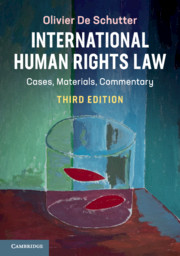80 results
Index
-
- Book:
- International Human Rights Law
- Published online:
- 20 July 2020
- Print publication:
- 12 September 2019, pp 1061-1076
-
- Chapter
- Export citation

International Human Rights Law
-
- Published online:
- 20 July 2020
- Print publication:
- 12 September 2019
-
- Textbook
- Export citation
Table of Treaties and Conventions
-
- Book:
- International Human Rights Law
- Published online:
- 20 July 2020
- Print publication:
- 12 September 2019, pp li-lxx
-
- Chapter
- Export citation
6 - Derogations in time of public emergency
- from Part II - The Substantive Obligations
-
- Book:
- International Human Rights Law
- Published online:
- 20 July 2020
- Print publication:
- 12 September 2019, pp 607-654
-
- Chapter
- Export citation
Part III - The Mechanisms of Protection
-
- Book:
- International Human Rights Law
- Published online:
- 20 July 2020
- Print publication:
- 12 September 2019, pp 807-1060
-
- Chapter
- Export citation
Introduction
-
- Book:
- International Human Rights Law
- Published online:
- 20 July 2020
- Print publication:
- 12 September 2019, pp 1-10
-
- Chapter
- Export citation
8 - Ensuring compliance with international human rights law: the role of national authorities
- from Part III - The Mechanisms of Protection
-
- Book:
- International Human Rights Law
- Published online:
- 20 July 2020
- Print publication:
- 12 September 2019, pp 809-868
-
- Chapter
- Export citation
Table of Figures
-
- Book:
- International Human Rights Law
- Published online:
- 20 July 2020
- Print publication:
- 12 September 2019, pp xiii-xiii
-
- Chapter
- Export citation
Copyright page
-
- Book:
- International Human Rights Law
- Published online:
- 20 July 2020
- Print publication:
- 12 September 2019, pp iv-iv
-
- Chapter
- Export citation
11 - Regional mechanisms of protection
- from Part III - The Mechanisms of Protection
-
- Book:
- International Human Rights Law
- Published online:
- 20 July 2020
- Print publication:
- 12 September 2019, pp 988-1060
-
- Chapter
- Export citation
Part II - The Substantive Obligations
-
- Book:
- International Human Rights Law
- Published online:
- 20 July 2020
- Print publication:
- 12 September 2019, pp 289-806
-
- Chapter
- Export citation
Table of Cases
-
- Book:
- International Human Rights Law
- Published online:
- 20 July 2020
- Print publication:
- 12 September 2019, pp xiv-l
-
- Chapter
- Export citation
9 - The United Nations human rights treaties system
- from Part III - The Mechanisms of Protection
-
- Book:
- International Human Rights Law
- Published online:
- 20 July 2020
- Print publication:
- 12 September 2019, pp 869-942
-
- Chapter
- Export citation
1 - The rise of international human rights
- from Part I - The Sources
-
- Book:
- International Human Rights Law
- Published online:
- 20 July 2020
- Print publication:
- 12 September 2019, pp 13-144
-
- Chapter
- Export citation
Part I - The Sources
-
- Book:
- International Human Rights Law
- Published online:
- 20 July 2020
- Print publication:
- 12 September 2019, pp 11-288
-
- Chapter
- Export citation
2 - State responsibility and ‘jurisdiction’
- from Part I - The Sources
-
- Book:
- International Human Rights Law
- Published online:
- 20 July 2020
- Print publication:
- 12 September 2019, pp 145-288
-
- Chapter
- Export citation
Contents
-
- Book:
- International Human Rights Law
- Published online:
- 20 July 2020
- Print publication:
- 12 September 2019, pp v-x
-
- Chapter
- Export citation
3 - Respecting human rights: avoiding interference
- from Part II - The Substantive Obligations
-
- Book:
- International Human Rights Law
- Published online:
- 20 July 2020
- Print publication:
- 12 September 2019, pp 291-435
-
- Chapter
- Export citation
5 - Fulfilling human rights: progressive realization
- from Part II - The Substantive Obligations
-
- Book:
- International Human Rights Law
- Published online:
- 20 July 2020
- Print publication:
- 12 September 2019, pp 557-606
-
- Chapter
- Export citation
Table of Boxes
-
- Book:
- International Human Rights Law
- Published online:
- 20 July 2020
- Print publication:
- 12 September 2019, pp xi-xii
-
- Chapter
- Export citation



